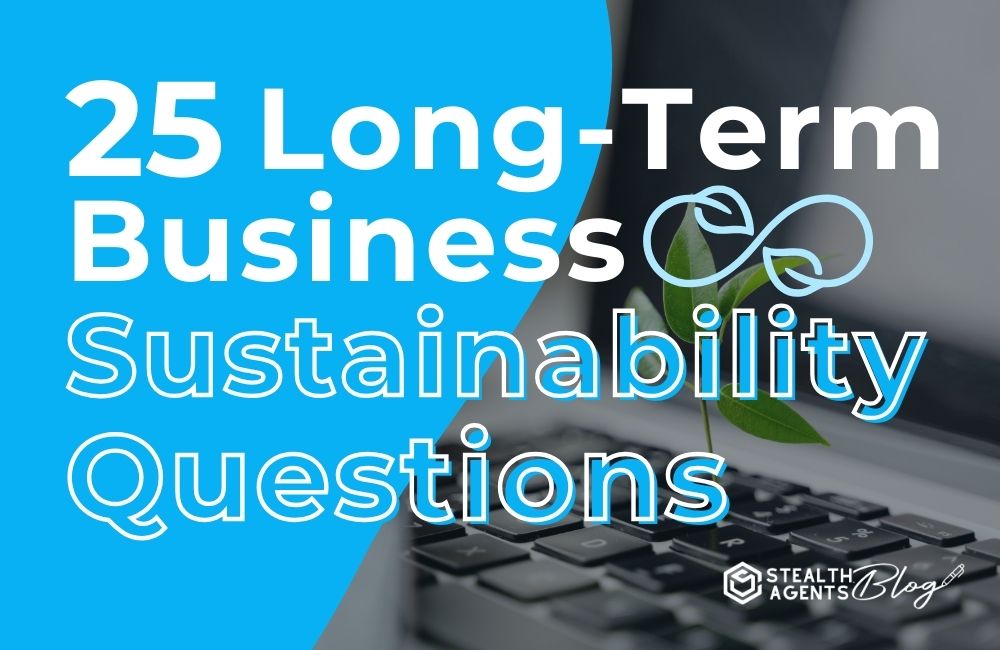Sustainability has transitioned from a buzzword to a business imperative. As a company owner or manager, you might be at the helm of a sustainability initiative, or you’re just starting to explore what it could mean for your future. One of the most powerful tools for change is inquiry – asking the right questions can lead to profound insights and set the stage for impactful action.
In this engaging listicle, root out your organization’s sustainability standing and potential areas for growth with our 25 probing questions. Whether you’re aiming for the stars or just getting off the ground, these queries can guide your journey toward a more sustainable and future-proof business.
Let’s dive in, and remember: the biggest changes often start with the simplest questions.
Why is Sustainability Essential for Long-Term Business Success?
Before we engage with the questions, it’s vital to understand the why behind this business focus. The reasons are as diverse as the businesses that pursue them:
-
Responsibility and Reputation: Consumers and stakeholders are increasingly favoring companies that act responsibly and ethically.
-
Cost Savings and Efficiency: Sustainability measures often lead to operational cost reductions, particularly in energy and resource usage.
-
Regulatory Compliance and Future-Proofing: Laws are tightening around corporate environmental impact, making future regulatory compliance easier and less costly for early adopters.
-
Risk Mitigation: Sustainability strategies can reduce risk from supply chain issues, resource scarcity, and climate-related events.
-
Competitive Advantage: Being sustainable can be a unique selling point, differentiating your brand from the competition.
-
Employee Engagement: Staff and labor forces are growing increasingly values-driven and are more attracted to companies that reflect their ethical concerns.
Now, let’s get down to business and ask those critical questions.
1. What Does Sustainability Mean to Us?
Starting with the basics, define what sustainability stands for within your organization. Does your definition encompass environmental stewardship, social responsibility, or economic longevity? Establish this internal measure to benchmark against in implementing business practices.
2. What Are Our Short and Long-Term Sustainability Goals?
Do you have a clear set of objectives? Both short-term wins and long-term visions are powerful motivators that keep sustainability at the forefront of your business strategy.
3. Are We Transparent About Our Sustainability Initiatives?
Communication is key. Transparency about your efforts builds trust with customers and partners, while also fostering a culture of accountability within your team.
4. How Do We Innovate with Sustainability in Mind?
Innovation is the engine of lasting change. Explore how you can embed sustainability into your products, services, and business models from the ground up, and consider green partnerships or alliances for mutual innovation.
5. Are We Regularly Assessing Our Environmental Impact?
Regular assessments help identify the largest impacts and set priorities for action. Are you measuring your carbon footprint, or do you know the water usage involved in your supply chain?
6. Have We Integrated Circular Economy Principles?
The concept of a circular economy, where resources are kept in use for as long as possible through recycling and reuse, offers a paradigm shift. Are there ways you can integrate this into your business?
7. How Sustainable Are Our Operations?
Review across the board: from your buildings’ energy efficiency to processes and policies, ensuring your operations reflect your commitment to sustainability.
8. Have We Engaged Our Suppliers and Partners in Our Sustainability Journey?
Your supply chain’s sustainability is intertwined with your own. Open a dialogue and take action together to multiply the effects of your efforts.
9. Are We Enabling a Healthy Work Environment?
Sustainability also applies to your staff. Health and wellness programs, mental health support, and stress management are part of building a sustainable business ecosystem.
10. How Are We Managing Waste and Emissions?
A waste and emissions audit can reveal significant potential for reductions. Consider processes like waste tracking software or re-engineering production to minimize pollution.
11. Are We Utilizing Renewable Energy and Green Technologies?
Transitioning to renewable energy and utilizing state-of-the-art green technologies is a large step towards sustainability, reducing your carbon footprint significantly.
12. What’s Our Strategy to Mitigate Climate Change Impact?
Assess your vulnerability and prepare a strong strategy. Can you create or support carbon offset projects? What about climate-resilient product designs?
13. How Are We Conserving and Sustaining Natural Resources?
Sustaining natural resources could mean using less water, sourcing materials sustainably, or ensuring responsible land use. What measures can you put in place?
14. Is Our Brand Messaging Consistent with Our Sustainability Actions?
Inconsistency can lead to skepticism. Ensure your outward messages about sustainability align closely with your operational practices and concrete achievements.
15. How Is Diversity and Inclusion a Part of Our Sustainability Effort?
A sustainable business is not only about the planet; it’s also about people. D&I initiatives create an inclusive and innovative culture that supports sustainable growth.
16. Are We Committed to Continuous Learning and Adaptation?
Sustainability is a journey, not a destination. Stay abreast of new developments, be willing to adapt, and foster a learning culture within your organization.
17. Have We Engaged with the Local Community and Beyond?
Effective sustainability often involves community development. Engage with local groups and invest in projects that foster sustainability beyond your business.
18. What’s Our Approach to Legal Compliance and Certification?
Staying on top of compliance is crucial. Are you meeting all current environmental regulations? Consider seeking out certifications such as LEED, B Corp, or Fair Trade.
19. How Are We Fostering Sustainable Leadership?
Empower and equip your leaders at all levels to champion sustainability, making it more than a corporate initiative but part of the DNA of your organization’s leadership.
20. Have We Encouraged Sustainable Behavior Among Our Customers?
Your products and services can shape consumer behavior. Are you informing, incentivizing, and enabling your customers to make more sustainable choices?
21. Are We Measuring the Impact of Our Corporate Social Responsibility (CSR)?
CSR initiatives can be an essential part of your sustainability narrative. Make sure you understand and communicate their real-world impacts.
22. How Does Sustainability Fit into Our Financial Reporting and Strategy?
The financial bottom line is a key indicator of success. How is sustainability reflected in your financial strategy and reporting?
23. What Risks and Opportunities Does Climate Change Present for Our Business?
A changing climate brings new challenges but also opens doors to innovation and adaptation. Consider your business’s unique position in this landscape.
24. How Can We Use Technology to Advance Our Sustainability Goals?
Emerging technologies can be powerful aids in sustainability efforts. Are you exploring green IT solutions, blockchain for supply chain transparency, or AI for energy efficiency?
25. Are We Working Towards a Regenerative Model for Business?
Regenerative business goes beyond ‘doing no harm,’ aiming to put back more than it takes. Is this a framework you can adopt or adapt in your own company?
Conclusion
In conclusion, embracing sustainability is a journey full of opportunities for growth, innovation, and a better world. Embedding these questions within your company’s practices can serve as a compass, guiding towards a more sustainable future. Remember, it’s not about having all the right answers, but about asking the right questions and acting upon the answers. Start your exploration today, and let’s build a greener, happier, and more secure future.











